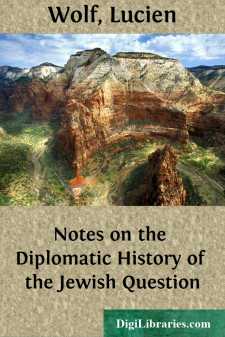Categories
- Antiques & Collectibles 13
- Architecture 36
- Art 48
- Bibles 22
- Biography & Autobiography 813
- Body, Mind & Spirit 142
- Business & Economics 28
- Children's Books 15
- Children's Fiction 12
- Computers 4
- Cooking 94
- Crafts & Hobbies 4
- Drama 346
- Education 46
- Family & Relationships 57
- Fiction 11828
- Games 19
- Gardening 17
- Health & Fitness 34
- History 1377
- House & Home 1
- Humor 147
- Juvenile Fiction 1873
- Juvenile Nonfiction 202
- Language Arts & Disciplines 88
- Law 16
- Literary Collections 686
- Literary Criticism 179
- Mathematics 13
- Medical 41
- Music 40
- Nature 179
- Non-Classifiable 1768
- Performing Arts 7
- Periodicals 1453
- Philosophy 64
- Photography 2
- Poetry 896
- Political Science 203
- Psychology 42
- Reference 154
- Religion 513
- Science 126
- Self-Help 84
- Social Science 81
- Sports & Recreation 34
- Study Aids 3
- Technology & Engineering 59
- Transportation 23
- Travel 463
- True Crime 29
Notes on the Diplomatic History of the Jewish Question
by: Lucien Wolf
Description:
Excerpt
I. INTRODUCTION.
ON INTERNATIONAL RELIGIOUS LIBERTY GENERALLY.
The Jewish Question is part of the general question of Religious Toleration. Together with the questions relating to the toleration of "Turks and Infidels," it raises the question of Religious Liberty in its most acute form. It is both local and international. Locally it seeks a solution through Civil and Political Emancipation on the basis of Religious Toleration. Internationally it arises when a State or combination of States which has been gained to the cause of Religious Toleration intervenes for the protection or emancipation of the oppressed Jewish subjects of another State. There have been, however, at least two occasions when the interventions have taken the contrary form of efforts to promote the persecution or restraint of Jews as such.
As an altruistic form of international action the principle of intervention has been of slow growth. It required an atmosphere of toleration on a wide scale, and, before this atmosphere could be created, Christian States had to learn toleration for themselves by a hard experience of its necessity. They had, in the first place, to secure toleration for their own nationals and the converts of their Churches in heathen countries where the people could not be coerced or lectured with impunity. In the next place they had to achieve toleration among themselves.
Toleration among the Christian Churches—the so-called peace of Christendom—became necessary owing to the struggle between the Reformation and the Counter-Reformation; but it took the Thirty Years' War to prove its necessity. The proof is embodied for all time in the Peace of Westphalia—chiefly in the Treaty of Osnabruck, which was signed in 1648, at the same time as the famous Treaty of Münster. The ostensible effect of the Peace of Westphalia was to place Roman Catholicism and Protestantism on an equal legal footing throughout Europe. A secondary effect was to give a very marked stimulus to the cause of Religious Liberty generally. We may recognise its first fruits in, among other things, the campaign for unrestricted religious toleration during the Commonwealth in England, and its application to the Jews.
It was not until 1814 that this principle was extended by Treaty beyond the pale of Christendom. This was in the Protocol of the four allied Powers—Great Britain, Russia, Prussia, and Austria—by which the union of Belgium with Holland was recognised. The return of the House of Orange to the Netherlands after the fall of Napoleon had entailed the promulgation of a new Constitution, which, in view of the democratic traditions of the French occupation, was necessarily of a liberal type. Among its concessions was an article granting the fullest religious liberty. When the Powers were called upon to sanction the union with Belgium, they did so on condition that the new Constitution should be applied to the whole country, and, in view of the religious differences prevailing, emphasised the article on Religious Liberty....


